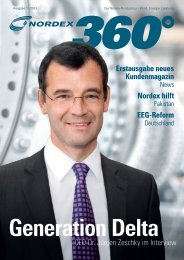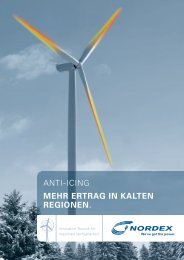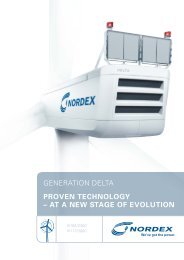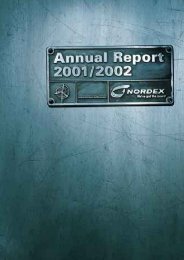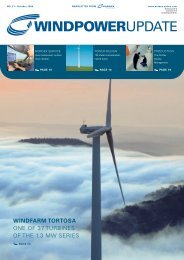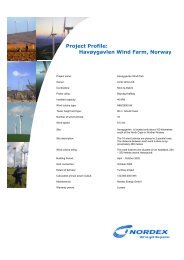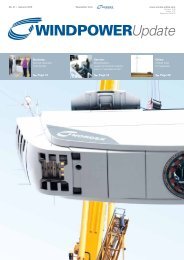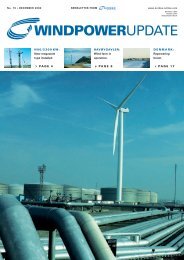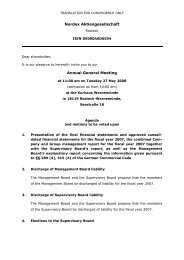OFFERING MEMORANDUM Global Offering of up to ... - Nordex
OFFERING MEMORANDUM Global Offering of up to ... - Nordex
OFFERING MEMORANDUM Global Offering of up to ... - Nordex
Create successful ePaper yourself
Turn your PDF publications into a flip-book with our unique Google optimized e-Paper software.
Standards Board (‘‘DRS’’), the charging <strong>of</strong> the company’s value <strong>to</strong> the gro<strong>up</strong>’s own equity in a manner<br />
that does not affect income is, however, not permissible. DRS has, inter alia, responsibility for<br />
developing recommendations regarding the application <strong>of</strong> the basic principles <strong>of</strong> consolidated<br />
accounting.<br />
According <strong>to</strong> currently applicable US GAAP, goodwill must be carried as an asset on the balance sheet<br />
and depreciated over the expected useful life, with 40 years being the maximum.<br />
According <strong>to</strong> IAS, goodwill also must be shown as an asset on the balance sheet with subsequent<br />
depreciation over the expected useful life. As a rule, the depreciable life is a maximum <strong>of</strong> 20 years;<br />
longer depreciable lives are possible in justified exceptional cases.<br />
Tangible Assets<br />
German companies frequently orient themselves in assessing depreciation for tangible assets<br />
(buildings, technical equipment, <strong>to</strong>ols, furniture and fixtures) on the useful life cus<strong>to</strong>mary for their<br />
company as laid down by the tax administration.<br />
According <strong>to</strong> US GAAP and IAS, tangible assets are depreciated on a straight-line basis over their<br />
expected useful life. This difference in depreciation policy can result in companies that prepare their<br />
balance sheet in accordance with the German Commercial Code basically showing a lower book value<br />
for tangible assets than companies that prepare their balance sheets in accordance with US GAAP or<br />
IAS. Tax-motivated special depreciation as well as tax-motivated reserves in ‘‘reserves for special<br />
depreciation’’ are prohibited under international principles for rendering accounts.<br />
According <strong>to</strong> IAS, a tangible asset can also be assessed with its ‘‘new valuation amount’’, which<br />
corresponds <strong>to</strong> its adjusted value (fair value) at the time <strong>of</strong> the new valuation, less subsequent<br />
cumulative normal depreciation. Increases in value are basically credited <strong>to</strong> a special valuation reserve<br />
with no effect on the balance sheet. A rise in value will be displayed as earnings <strong>to</strong> the extent that an<br />
earlier new valuation gave rise <strong>to</strong> an expense-related depreciation.<br />
Reserves<br />
The German Commercial Code provisions require the creation <strong>of</strong> reserves for uncertain obligations as<br />
well as for threatened losses from pending and unsettled business transactions. The level <strong>of</strong> reserves is<br />
measured according <strong>to</strong> the expenditure expected by a prudent and reasonable businessman. Reserves<br />
for threatened losses from pending business transactions include all internal expenditures, including<br />
indirect marketing and administrative expenses. Reserves for uncertain obligations <strong>to</strong>wards third<br />
parties are recorded as soon as a legal obligation <strong>to</strong>wards a third party has arisen or at least has been<br />
caused in an economic sense.<br />
Reserves may also be formed in German financial statements under HGB for expenditures that are<br />
exactly outlined and assigned <strong>to</strong> a financial year or <strong>to</strong> an earlier financial year and that, on the key date<br />
for the financial statement, are probable or certain, but their amount or the time they will occur is<br />
indefinite.<br />
According <strong>to</strong> US GAAP and IAS, reserves for uncertain obligations are expressed not only when it is<br />
probable that the assets will diminish or an obligation has arisen, but also when the least loss can be<br />
estimated reliably. Future losses that cannot be estimated and costs and risks do not fit the<br />
requirements for the formation <strong>of</strong> reserves according <strong>to</strong> US GAAP and IAS. Application <strong>of</strong> German<br />
Commercial Code provisions can — especially because <strong>of</strong> the strong influence <strong>of</strong> tax-related<br />
considerations — lead <strong>to</strong> higher reserves than are possible under US GAAP and IAS. In the case <strong>of</strong> a<br />
reduction <strong>of</strong> reserves in later periods, however, this effect would be reversed.<br />
Long-term reserves for removal <strong>of</strong> waste rock or rubble or for the disposal <strong>of</strong> environmental waste,<br />
which under HGB accumulate over the period <strong>of</strong> the accompanying installations, are, under IAS,<br />
already accounted for at the time <strong>of</strong> the acquisition <strong>of</strong> the installation in the amount <strong>of</strong> the present<br />
value <strong>of</strong> the estimated completion. These future expenditures count as acquisition costs <strong>of</strong> the<br />
installation in the same amount as the reserves amount. The period expenditure from this results from<br />
B-2



